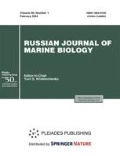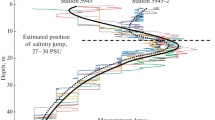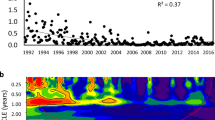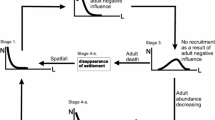Abstract
Communities of epiphytic diatoms develop seasonally. On macroalgae, they reach the highest density in the middle of summer and decline to a minimum value in winter. This discrete pattern makes it possible to use the tool of difference (recurrent) equations for testing the concept of density regulation on the interannual dynamics of the number of epiphytic diatoms. The properties of the obtained multi-step recurrent models for the interannual dynamics of the number of diatoms in the epiphyton of the macroalga Ulva lactuca Linnaeus collected from three areas of coastal waters in Peter the Great Bay, Sea of Japan (Amur Bay, Ussuri Bay, and Stark Strait), are considered. The proposed multi-step recurrent models do not contradict the primary data of observations. Each of the obtained descriptions for different water areas is characterized by its specific pattern of dynamics. The reproductive capacity of epiphytic diatom community is the lowest in the Stark Strait; the highest reproductive capacity is observed in Amur Bay. According to the models, the epiphytic diatom communities in different parts of Peter the Great Bay exhibit generally complex, pseudochaotic, dynamics of their number.










Similar content being viewed by others
REFERENCES
Levchenko, E.V. and Begun, A.A., Diatom algae of epiphyton on seaweeds in the Sobol Bay (Ussuri Bay, Sea of Japan), Izv. Tikhookean. Nauchno–Issled. Inst. Rybn. Khoz. Okeanogr., 2008, vol. 154, pp. 248–258.
Parensky, V.A., Dynamics of abundance and fishing of pink salmon Oncorhynchus gorbuscha, Vopr. Ikhtiol., 2003, vol. 43, no. 3, pp. 352–360.
Proshkina-Lavrenko, A.I., Diatomovye vodorosli bentosa Chernogo morya (Diatoms of the Black Sea Benthos), Moscow: Akad. Nauk SSSR, 1963.
Ryabushko, L.I., Potentsial’no opasnye mikrovodorosli Azovo-Chernomorskogo basseina (Potentially Harmful Microalgae of the Azov-Black Sea Basin), Sevastopol: EKOSI-Gidrofizika, 2003.
Ryabushko, L.I. and Bondarenko, A.V., Mikrovodorosli planktona i bentosa Azovskogo morya (chek-list, sinonimika, kommentarii) (Plankton and Benthos Microalgae of the Sea of Azov (Check-list, Synonyms, and Commentary)), Sevastopol: EKOSI-Gidrofizika, 2011.
Svirezhev, Yu.M. and Logofet, D.O., Stability of Biological Communities, Moscow: Mir, 1983.
Shapiro, A.P. and Luppov, S.P., Rekurrentnye uravneniya v teorii populyatsionnoi biologii (Recurrent Equations in the Theory of Population Biology), Moscow: Nauka, 1983.
Guiry, M.D. and Guiry, G.M., AlgaeBase. World-wide Electronic Publication, Galway: Natl. Univ. Ireland, 2017. http://www.algaebase.org. Cited Decemder 18, 2017.
Harlin, M.M., Seagrass epiphytes, in Handbook of Seagrass Biology: An Ecosystem Perspective, Phillips, R.C. and McRoy, C.P., Eds., New York: Garland STPM Press, 1980, pp. 117–151.
Mabrouk, L., Brahim, M.B., Hamza, A., et al., A comparison of abundance and diversity of epiphytic microalgal assemblages on the leaves of the seagrasses Posidonia oceanica (L.) and Cymodocea nodosa (Ucria) Asch in Eastern Tunisia, J. Mar. Biol., vol. 2014, Art. ID 275305. doi 10.1155/2014/275305
May, R.M., Biological populations obeying difference equations: stable points, stable cycles, and chaos, J. Theor. Biol., 1975, vol. 51, no. 2, pp. 511–524.
May, R.M. and Oster, G.F., Bifurcations and dynamic complexity in simple ecological models, Am. Nat., 1976, vol. 110, no. 974, pp. 573–599.
Paulick, G.J., Studies of the possible form of the stock and recruitment curve, Rapp. P.-V. Réun. - Cons. Int. Explor. Mer, 1973, vol. 164, pp. 302–315.
Pollard, J.H., A Handbook of Numerical and Statistical Techniques: With Examples Mainly from the Life Sciences, Cambridge: Cambridge Univ. Press, 1977.
Ricker, W.E., Stock and recruitment, J. Fish. Res. Board Can., 1954, vol. 11, no. 5, pp. 559–623.
Round, F.E., Crawford, R.M., and Mann, D.G., The Diatoms: Biology and Morphology of the Genera, Cambridge: Cambridge Univ. Press, 1990.
Totti, C., Poulin M., Romagnoli, T., et al., Epiphytic diatom communities on intertidal seaweeds from Iceland, Polar Biol., 2009, vol. 32, pp. 1681–1691. doi 10.1007/s00300-009-0668-4
Wilkinson, L., Hill, M.-A., Welna, J.P., and Birkenbeuel, G.K., SYSTAT for Windows: Statistics. Version 5, Evanston, Ill.: SYSTAT Inc., 1992.
Author information
Authors and Affiliations
Corresponding author
Additional information
Translated by E. Shvetsov
Rights and permissions
About this article
Cite this article
Parensky, V.A., Levchenko, E.V. A Study of the Properties of the Multi-Step Recurrent Models for the Interannual Dynamics of Epiphytic Diatom Communities. Russ J Mar Biol 44, 580–591 (2018). https://doi.org/10.1134/S1063074018070064
Received:
Accepted:
Published:
Issue Date:
DOI: https://doi.org/10.1134/S1063074018070064




